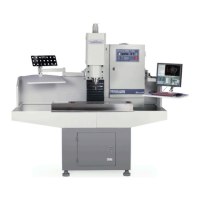Chapter 7
88
UM10349_PCNC1100_Manual_0916A
Programming
Rotaonal Axis
The A-axis is a rotaonal axis. In general, the axis of rotaon can be collinear to a primary linear axis,
or arbitrary. In usual pracce, the axis of rotaon of the A-axis is typically collinear to the X-axis.
Posion is measured in degrees. It is treated as a wrapped linear axis, meaning that the angular
posion increases without limit (goes toward plus innity) as the axis turns counterclockwise and
decreases without limit (goes toward minus innity) as the axis turns clockwise. The direcon of
posive rotaon is counterclockwise when viewed from the posive end of the corresponding
X-, Y- or Z-axis.
Controlled Point
The controlled point is the point whose posion and rate of moon are controlled. In praccal
applicaon, this point is located somewhere along the spindle axis (Z-axis). The locaon of the
controlled point can be moved out along the spindle axis by specifying some posive value for the
tool length oset. This value is normally the length of the cung tool in use, so that the controlled
point is eecvely located at the boom center of the cung tool.
Work Envelope
The work envelope is dened by the space that can be reached by the controlled point.
Current Posion
The controlled point is always at a locaon called the current posion and the operang system
always knows where that is. Moving the controlled point changes the current locaon. The current
posion is dened by the values displayed on the digital readouts (DRO).
The current posion can also be changed without any actual movement of the controlled point if
any of several events take place:
• Length unit mode (G20/G21) is changed
• Tool length oset is changed
• Work oset is changed
Each of these events can change the values displayed in the DROs.
Coordinated Linear Moon
Coordinated linear moon describes a situaon in which, nominally, each linear axis (X-, Y-, or Z-axis)
moves at a constant speed and all axes move from their starng posions to their end posions at
the same me. This produces moon in a straight line. Coordinated linear moon can be performed
either at the prevailing feed rate or at rapid traverse rate. If physical limits on axis speed make the
desired rate unobtainable, all axes are slowed to maintain the desired path.
In actual moon, it is oen not possible to maintain constant speed because acceleraon or
deceleraon is required at the beginning and/or end of the moon.

